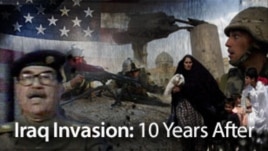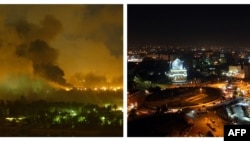Ali Ismail Abbas was 12 when the Iraq war began, changing his life forever.
During the invasion, a U.S. missile exploded near his family's home south of Baghdad.
Ali recalled the tragic results in a 2011 interview with "Time" magazine:
Ali lost both of his arms and suffered burns to 60 percent of his body. Doctors in Baghdad didn't think he would live to see his 13th birthday.
After photographs of Ali in a Baghdad hospital were published around the world, he unwillingly became the iconic face of the war's toll on innocent civilians.
Casualty Figures
Estimates of civilian deaths in Iraq vary greatly depending on who reports the figures and how they compile information.

One of the more comprehensive efforts, conducted by the Iraq Body Count project, estimates that more than 121,000 Iraqi civilians died as a result of coalition and militant attacks, sectarian violence, and increased criminal activity until the end of 2012.
Figures published by the British journal "The Lancet" suggest that nearly 117,000 Iraqi noncombatants died between the outbreak of the war and the U.S. withdrawal in December 2011.
Iraq's Human Rights Ministry, meanwhile, recorded 250,000 Iraqi injuries by the end of 2012. Iraq's Health Ministry has estimated that more than 150,000 civilians had been killed as the result of the war and sectarian fighting by mid-2006, just three years into the 8 1/2-year war.
Classified U.S. military documents released by WikiLeaks recorded more than 66,000 civilian deaths from 2004 through the end of 2009 -- the years when sectarian violence reached its peak.
The highest death toll was in a survey by Opinion Research Business in August 2007. Based on the questioning of 2,000 Iraqi adults, it statistically projected that about 1 million were killed in the first 4 1/2 years of fighting.
Face In A Crowd
Ali narrowly avoided adding to the death toll. He was flown to Kuwait for lifesaving surgery after his story became international news and offers of help poured in from around the world.
A British charity called the Limbless Association subsequently set up a fund in Ali's name and moved him to London along with Ahmed Farhan, a 14-year-old he befriended in Kuwait who lost an arm and a leg in a separate U.S. missile strike.
The Limbless Association used the donations to buy prosthetic limbs for the two boys.
As they continued their recovery, both began to play soccer with the charity's team -- the "L.A. Spurs" -- under the guidance of volunteer coach Dean Heffer.
To this day, Ali and Ahmed play with the team, and Heffer says Ali's recovery has been inspirational.
"I'm sure [soccer has] played a big part in his rehabilitation -- to be able to get out and play the game he loves," Heffer says. "Myself being an amputee as well, it changed my life. And we want to help other amputees follow that pathway. After his terrible tragedy, football has given him something to focus on and help concentrate his mind on. And when he's out there on the pitch you're just thinking of the game. All other things just go out of your mind for that time."
Ali learned to write and use a computer with his feet in Britain. He also learned to speak English, using donations to attend the privately funded Hall School Wimbledon.
After graduation, he passed the test to become a British citizen in 2010.
PHOTO GALLERY: 10 Years Of Change Since The Invasion
Although he still lives in London, he returns to Iraq every year and has been reunited with his surviving sisters.
In November 2012, Ali married his childhood friend, Ankam Hamza, in a traditional Muslim wedding ceremony in Iraq. He now talks about the importance of charity work to help other Iraqis who have become part of the war's civilian toll.
During the invasion, a U.S. missile exploded near his family's home south of Baghdad.
Ali recalled the tragic results in a 2011 interview with "Time" magazine:
"We were all asleep. It was 12 o'clock in the night. We just heard a big noise, a big bang near to my house. So my house, all the ceiling and the walls fell on us and the fire was all over the house. I heard my family screaming and I felt the fire on my body and I couldn't see anything. I lost my father, brother, and my mother, and 13 other members of my family."
Ali lost both of his arms and suffered burns to 60 percent of his body. Doctors in Baghdad didn't think he would live to see his 13th birthday.
After photographs of Ali in a Baghdad hospital were published around the world, he unwillingly became the iconic face of the war's toll on innocent civilians.
Casualty Figures
Estimates of civilian deaths in Iraq vary greatly depending on who reports the figures and how they compile information.

One of the more comprehensive efforts, conducted by the Iraq Body Count project, estimates that more than 121,000 Iraqi civilians died as a result of coalition and militant attacks, sectarian violence, and increased criminal activity until the end of 2012.
Figures published by the British journal "The Lancet" suggest that nearly 117,000 Iraqi noncombatants died between the outbreak of the war and the U.S. withdrawal in December 2011.
MORE ICONS OF THE IRAQ WAR: Abu Ghraib's Lynndie England
Iraq's Human Rights Ministry, meanwhile, recorded 250,000 Iraqi injuries by the end of 2012. Iraq's Health Ministry has estimated that more than 150,000 civilians had been killed as the result of the war and sectarian fighting by mid-2006, just three years into the 8 1/2-year war.
Classified U.S. military documents released by WikiLeaks recorded more than 66,000 civilian deaths from 2004 through the end of 2009 -- the years when sectarian violence reached its peak.
MORE ICONS OF THE IRAQ WAR: Shoe-Thrower Muntadhar Al-Zaidi
The highest death toll was in a survey by Opinion Research Business in August 2007. Based on the questioning of 2,000 Iraqi adults, it statistically projected that about 1 million were killed in the first 4 1/2 years of fighting.
Face In A Crowd
Ali narrowly avoided adding to the death toll. He was flown to Kuwait for lifesaving surgery after his story became international news and offers of help poured in from around the world.
A British charity called the Limbless Association subsequently set up a fund in Ali's name and moved him to London along with Ahmed Farhan, a 14-year-old he befriended in Kuwait who lost an arm and a leg in a separate U.S. missile strike.
MORE ICONS OF THE IRAQ WAR: Ahmed Chalabi And The Case For War
The Limbless Association used the donations to buy prosthetic limbs for the two boys.
As they continued their recovery, both began to play soccer with the charity's team -- the "L.A. Spurs" -- under the guidance of volunteer coach Dean Heffer.
To this day, Ali and Ahmed play with the team, and Heffer says Ali's recovery has been inspirational.
"I'm sure [soccer has] played a big part in his rehabilitation -- to be able to get out and play the game he loves," Heffer says. "Myself being an amputee as well, it changed my life. And we want to help other amputees follow that pathway. After his terrible tragedy, football has given him something to focus on and help concentrate his mind on. And when he's out there on the pitch you're just thinking of the game. All other things just go out of your mind for that time."
Ali learned to write and use a computer with his feet in Britain. He also learned to speak English, using donations to attend the privately funded Hall School Wimbledon.
After graduation, he passed the test to become a British citizen in 2010.
PHOTO GALLERY: 10 Years Of Change Since The Invasion
Although he still lives in London, he returns to Iraq every year and has been reunited with his surviving sisters.
In November 2012, Ali married his childhood friend, Ankam Hamza, in a traditional Muslim wedding ceremony in Iraq. He now talks about the importance of charity work to help other Iraqis who have become part of the war's civilian toll.













